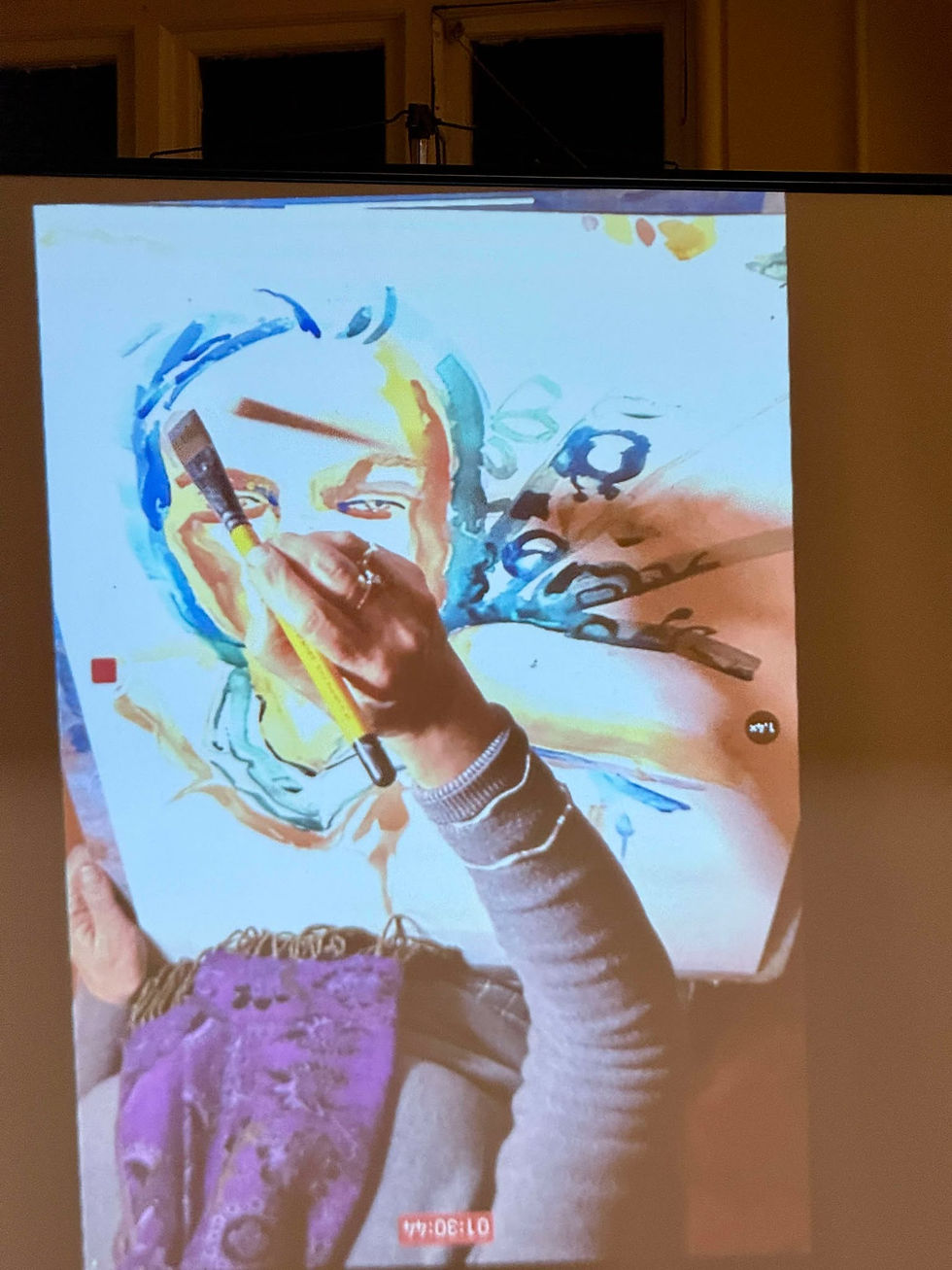Bringing Light into Darkness: Debbie Hinks' Watercolor Portrait Demo
- Carshalton and Wallington Art Group

- Mar 15
- 3 min read
On a chilly evening filled with eager anticipation, we gathered to witness a mesmerizing watercolor demonstration by Debbie Hinks, a master of portraiture in translucent washes. Her subject: a woman partially shrouded in shadow, her face illuminated by a dramatic, moody light. What followed was a spellbinding journey into Debbie’s approach to portrait painting—one that effortlessly blends technical skill, spontaneity, and artistic intuition.
Here’s a revised title with the focus keyword included: Watercolor Portrait Demo: Setting the Scene for a Thoughtful Beginning
Debbie began by discussing her palette choices, laying out a carefully curated selection of colors—some familiar staples, others there for flexibility. She explained the importance of having all colors visible rather than tucked away in tubes, ensuring she doesn’t overlook an ideal hue in the moment of creation.
She primed her paper with a toned background, a technique she finds useful in setting a cohesive mood. This underpainting, a delicate blend of blues and warm neutrals, immediately added a sense of atmosphere to the portrait.
The First Washes: Sculpting with Light with this Watercolor Portrait Demo

Using a loose, confident approach, Debbie laid in her first washes with diluted warm tones, defining the major shadow areas. The key here was to avoid overworking—"Let the water do the work," she reminded us, as pigments blended effortlessly on the paper.
Her use of negative space was particularly striking. Instead of outlining the face rigidly, she let the contrast between light and dark emerge naturally. The areas catching the light were left almost untouched, while soft siennas and ochres defined the contours of the face.

Building Depth: The Shadow Play
As the portrait took shape, the power of subtle layering became apparent. Debbie deepened shadows with gentle glazes of ultramarine, burnt sienna, and alizarin crimson, balancing warmth and coolness to keep the shadows rich but not muddy.
She frequently stepped back, assessing her work from a distance—a crucial habit in portrait painting. “Step away from the painting, and you’ll see what needs adjusting,” she advised, a tip worth remembering for any artist struggling with over-fiddling.

The Magic of Details: Bringing the Face to Life
With the structure established, Debbie moved to the eyes and lips, where personality and emotion truly emerge. Using a fine brush, she delicately defined the shadows around the eyes, ensuring they remained luminous and expressive.
One of the most fascinating moments was when she introduced unexpected color into the shadows—a touch of blue in the cheek, a hint of green near the jawline. "Shadows aren’t just grey—they reflect everything around them," she explained.
Her approach to the lips was equally masterful. Instead of over-defining them, she let soft edges blend seamlessly into the surrounding skin tones, ensuring they felt natural rather than pasted on.

Final Touches: Enhancing the Drama
As the portrait neared completion, Debbie introduced bolder strokes of deep blue and warm reds in the background, amplifying the dramatic lighting effect. A final glaze over certain shadow areas added cohesion, tying the piece together.
Perhaps the most inspiring takeaway was Debbie’s fearlessness—her willingness to embrace bold, fluid strokes, trusting the medium’s unpredictable nature.


The Takeaway: Learning from the Master
Debbie’s watercolor demo was more than just a lesson in technique—it was a masterclass in seeing, interpreting, and embracing the fluidity of the medium. Her ability to balance spontaneity with precision, softness with boldness, and light with shadow left us all deeply inspired.
For those looking to improve their own watercolor portraits, here are some key takeaways from Debbie’s process:
Start with a strong composition—think about light direction and shadow shapes before picking up the brush.
Use transparent layers to build depth rather than going in with heavy, opaque applications.
Let water work for you—embrace happy accidents and natural pigment diffusion.
Step back frequently to assess your painting as a whole.
Don’t fear unexpected colors—shadows can have blues, purples, or even greens, creating a more lifelike effect.
Debbie’s demo was a reminder that watercolor is about movement, confidence, and trust. Whether you're a beginner or a seasoned artist, her approach encourages you to let go of control and let the magic of water do its work.
This was truly an evening of inspiration, learning, and artistic energy. If you ever get a chance to watch Debbie Hinks in action, don’t miss it—her passion for watercolor portraiture is nothing short of contagious!
You can connect with Debbie through her social media and website mentioned below.








Comments